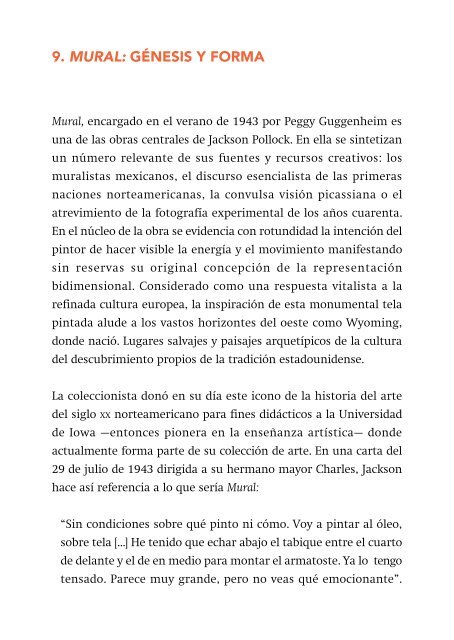MURAL JACKSON POLLOCK
cuadernillo_Jackson_Pollock
cuadernillo_Jackson_Pollock
Create successful ePaper yourself
Turn your PDF publications into a flip-book with our unique Google optimized e-Paper software.
9. <strong>MURAL</strong>: GÉNESIS Y FORMA<br />
9. <strong>MURAL</strong>: GENESIS AND FORM<br />
Mural, encargado en el verano de 1943 por Peggy Guggenheim es<br />
una de las obras centrales de Jackson Pollock. En ella se sintetizan<br />
un número relevante de sus fuentes y recursos creativos: los<br />
muralistas mexicanos, el discurso esencialista de las primeras<br />
naciones norteamericanas, la convulsa visión picassiana o el<br />
atrevimiento de la fotografía experimental de los años cuarenta.<br />
En el núcleo de la obra se evidencia con rotundidad la intención del<br />
pintor de hacer visible la energía y el movimiento manifestando<br />
sin reservas su original concepción de la representación<br />
bidimensional. Considerado como una respuesta vitalista a la<br />
refinada cultura europea, la inspiración de esta monumental tela<br />
pintada alude a los vastos horizontes del oeste como Wyoming,<br />
donde nació. Lugares salvajes y paisajes arquetípicos de la cultura<br />
del descubrimiento propios de la tradición estadounidense.<br />
Mural, commissioned by Peggy Guggenheim in the summer<br />
of 1943, is one of Pollock’s major works. It synthesises a large<br />
number of his creative sources and key referents, such as the<br />
Mexican muralists, the essentialist discourse of North America’s<br />
First Nations, the convulsive vision of Picasso, and the intrepid<br />
achievements of the experimental photography of the 1940s.<br />
Clearly evident in this work is the painter’s intention to make<br />
energy and movement visible by unreservedly manifesting his<br />
original concept of two-dimensional representation. Regarded as a<br />
natural response to the refined culture of Europe, the inspiration<br />
behind this monumental painted canvas points to the vast<br />
horizons of the West, like those of his birthplace, Wyoming. Such<br />
wilderness areas are the archetypal landscapes of the culture of<br />
discovery specific to the tradition of the United States.<br />
La coleccionista donó en su día este icono de la historia del arte<br />
del siglo xx norteamericano para fines didácticos a la Universidad<br />
de Iowa —entonces pionera en la enseñanza artística— donde<br />
actualmente forma parte de su colección de arte. En una carta del<br />
29 de julio de 1943 dirigida a su hermano mayor Charles, Jackson<br />
hace así referencia a lo que sería Mural:<br />
“Sin condiciones sobre qué pinto ni cómo. Voy a pintar al óleo,<br />
sobre tela [...] He tenido que echar abajo el tabique entre el cuarto<br />
de delante y el de en medio para montar el armatoste. Ya lo tengo<br />
tensado. Parece muy grande, pero no veas qué emocionante”.<br />
This icon of 20th-century American art was donated by its owner<br />
for educational purposes to the University of Iowa, then a pioneer<br />
in art education, to whose collection it currently belongs. In a<br />
letter of 29 July 1943 to his elder brother, Charles, Jackson states<br />
the following of the commission that was to become Mural:<br />
“With no strings as to what or how I paint it. I am going to paint<br />
it in oil on canvas. […] I’ve had to tear out the partition between<br />
the front and middle room to get the damned thing up. I have it<br />
stretched now. It looks pretty big but exciting.”


